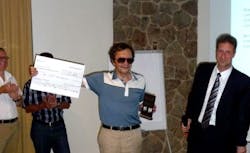Sant Feliu de Guixols, Spain--During BEC 2011: Frontiers in Quantum Gases conference (September 10-16), Dr. Ian Spielman and Prof. Gora Shlyapnikov were honored for their contributions to the field of Bose-Einstein Condensation (BEC). The award was presented by Dr. Jürgen Stuhler of Toptica Photonics (Martinsried, Germany) presented the two 2011 BEC awards to Professor Gora Shlyapnikov (Senior Award) and Dr. Ian Spielman (Junior award). The prizes honor “outstanding research in experimental and/or theoretical physics of quantum degenerate atomic gases.”
The Senior BEC Award went to Shlyapnikov for his “outstanding contributions to the development of the many-body theory of trapped quantum gases of bosonic and fermionic atoms and molecules.” He is Director of Research at the Laboratoire de Physique Théorique et Modèles Statistiques (CNRS and Université Paris-Sud, France) and part-time Professor of Physics at the University of Amsterdam.
Spielman received the Junior BEC Award for the “first experimental realization of synthetic magnetic fields and spin-orbit couplings in atomic Bose-Einstein condensates.” He is a researcher at the National Institute of Standards and Technology (NIST Gaithersburg, MD, USA) and a Fellow of the Joint Quantum Institute in Maryland.
Topica, a maker of tunable diode lasers and ultrafast fiber lasers, presents these 2500-euro awards to a Senior and Junior academic leader in the field biannually at the BEC Conference Series. Winners are selected by an ndependent international Jury.
"Toptica sponsors the prize in order to recognize the amazing advances in the field of quantum degenerate gases and the impact this has had on Toptica's development,” stated Wilhelm Kaenders, CEO of Toptica Photonics.
Lasers are the key instruments for degenerate quantum gases experiments. They are needed to laser cool, optically pump, optically trap, resonantly illuminate and coherently transfer the atoms. Usually, one experimental apparatus needs many lasers at different wavelengths, most of them locked very precisely with respect to atomic resonances. Research can only lead to results if all lasers are operating at the same time with the desired characteristics, such as linewidth, power, and frequency.
SOURCE: Toptica Photonics
Subscribe now to Laser Focus World magazine; It’s free!
Follow us on Twitter
Sponsored Recommendations
Sponsored Recommendations
Request a free Micro 3D Printed sample part
April 11, 2024
How to Tune Servo Systems: The Basics
April 10, 2024
Voice your opinion!
Voice your opinion!

